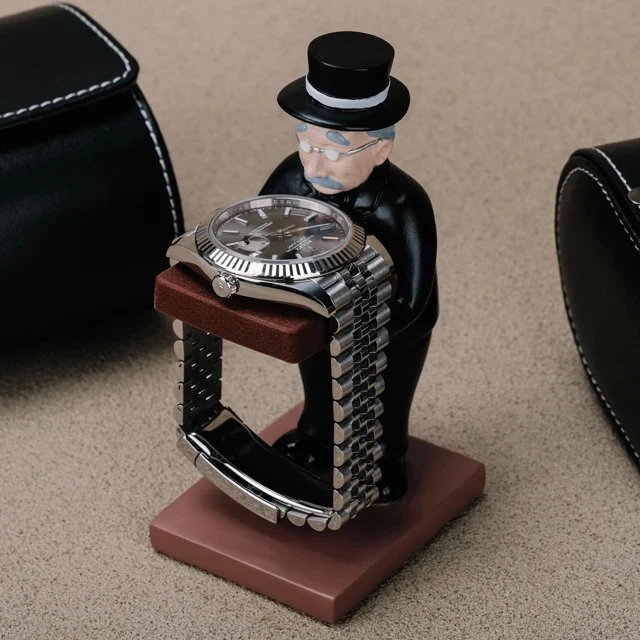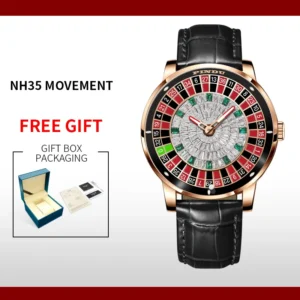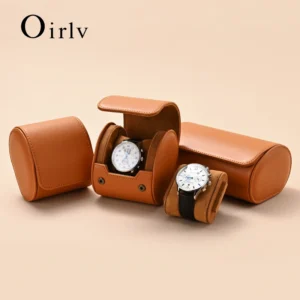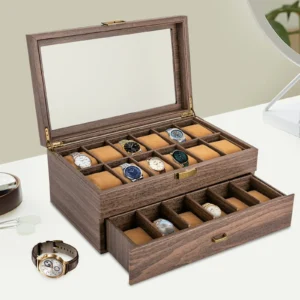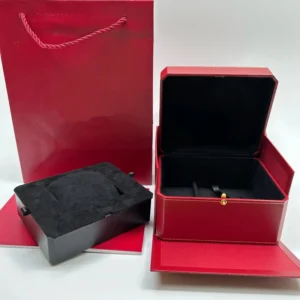When you invest in a quality timepiece, proper storage becomes essential for maintaining its beauty and functionality. Many watch enthusiasts find themselves confused about the differences between watch holders and organizers—terms often used interchangeably but representing distinct storage solutions. Improper storage can lead to scratches, dust accumulation, and even mechanical issues that affect your watch’s performance and longevity.
For those who appreciate fine watches, understanding these differences isn’t just about semantics—it’s about preserving your investment. Proper storage solutions play a crucial role in maintaining the appearance of your timepieces and protecting their intricate mechanisms. According to industry experts, watches regularly exposed to dust and moisture can experience significant performance issues within just a few years.
In this comprehensive guide, we’ll clearly differentiate between watch holders and organizers, examining their unique characteristics, benefits, and ideal uses. Whether you have a single prized watch or an extensive collection, this information will help you make informed decisions about organizing your watch collection effectively.
We’ll begin by defining each term, explore the various types available, compare their features, and provide specific recommendations based on your collection needs. Let’s dive in and discover which solution best suits your timepieces.
What Are Watch Holders: Definition and Purpose
Watch holders are relatively simple devices designed primarily for displaying a single watch or a small number of watches. Their primary function centers around quick access, visual display, and temporary storage rather than long-term protection.
Key characteristics that define watch holders include:
- Open-faced or compact designs that prioritize visibility
- Focus on easy accessibility for daily wear watches
- Moderate to minimal protection from environmental factors
- Typically accommodate 1-4 watches at maximum
- Emphasis on aesthetic appeal and/or portability
- Designed for convenience rather than comprehensive protection
These products commonly feature materials like wood, metal, leather, or silicone, depending on their specific purpose. Most watch holders range from $15 to $75, though premium materials and craftsmanship can push prices higher.
Watch holders serve as excellent solutions for displaying your favorite timepieces while keeping them readily accessible. They’re perfect for those who rotate between a few watches regularly and want a designated spot to place them when not worn.
Popular Types of Watch Holders
Watch Stands
Watch stands are pedestal-like structures designed to showcase a single timepiece. They typically feature a vertical orientation that allows the watch to be displayed upright, mimicking how it would look on your wrist.
Ideal usage: Perfect for placing on a desk, dresser, or nightstand for easy access to your daily wear watch.
Advantages:
– Excellent visibility and aesthetic presentation
– Easy access for frequently worn watches
– Often compact, requiring minimal space
– Showcase-quality display for prized timepieces
Limitations:
– Minimal protection from dust and UV exposure
– No security features
– Limited capacity (usually one watch)
– Not suitable for travel or storage
Watch Rolls
Watch rolls are cylindrical cases with individual compartments or dividers, typically made from leather, canvas, or suede materials. They’re designed to securely hold multiple watches in a compact, portable form.
Ideal usage: Perfect for travel or for storing a small collection in a drawer.
Benefits:
– Highly portable and compact
– Individual compartments prevent watches from touching
– Good basic protection against scratches
– Space-efficient storage
– Often feature elegant materials like quality leather
Drawbacks:
– Less robust protection than hard cases
– Limited capacity (typically 2-6 watches)
– Not ideal for display purposes
– Minimal protection against impact
Watch Pouches/Slipcases
Watch pouches are soft, individual bags designed to hold a single timepiece. They’re often made from microfiber, felt, leather, or similar soft materials that protect the watch’s surface from scratches.
Best use scenarios: Ideal for protecting individual watches during travel or when stored inside a larger bag or luggage.
Strengths:
– Ultra-portable and lightweight
– Excellent scratch protection
– Affordable and space-efficient
– Easy to use for single watches
Weaknesses:
– Minimal impact or crush protection
– No display capability
– Limited to single-watch storage
– No organization features for collections
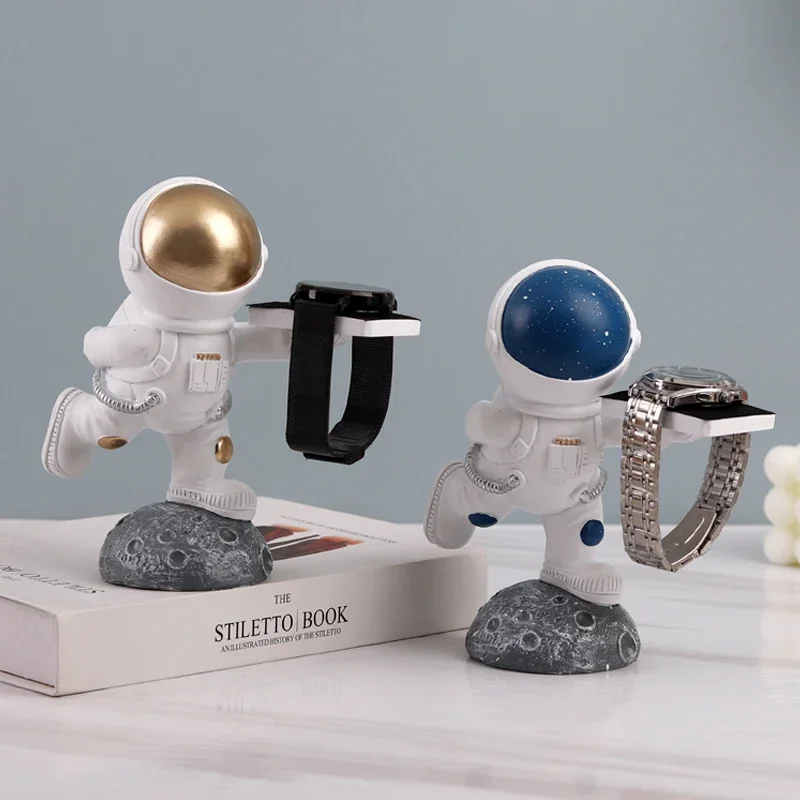
The right watch display holder depends largely on how you use your watches. For those who travel frequently, understanding the differences between watch boxes vs. watch rolls can help you make the best choice. Many travelers find that quality watch roll travel cases offer the perfect balance of protection and portability.
What Are Watch Organizers: Definition and Purpose
Watch organizers are more comprehensive storage solutions designed specifically for collecting, protecting, and systematically arranging multiple watches. While holders focus on display and accessibility, organizers prioritize collection management and long-term protection.
The defining characteristics of watch organizers include:
- Enclosed, typically lidded designs that shield watches from environmental factors
- Individual compartments or cushions for each timepiece
- Robust protection against dust, moisture, light, and physical damage
- Capacity for larger collections (generally 5+ watches)
- Focus on both protection and organization
- Often include additional security features
These products commonly use premium materials like hardwoods, quality leather, glass, and soft interior linings. Most quality watch organizers range from $60 to $300+, with high-end options featuring exotic woods or additional functionality commanding higher prices.
Watch organizers represent a more significant investment than simple holders but provide substantially more protection and organization capability. For collectors with multiple timepieces, these solutions help maintain watch value while keeping the collection properly arranged and protected.
Understanding the different types of watch storage available is essential for making an informed decision about which system will work best for your specific needs and collection size.
Popular Types of Watch Organizers
Watch Boxes
Watch boxes are enclosed containers with multiple padded slots or cushions designed to hold watches securely in place while protecting them from environmental factors. They typically feature a lid that completely encloses the watches when closed.
Ideal use scenarios: Perfect for home storage of watch collections, providing both protection and display capabilities.
Advantages:
– Excellent protection against dust and environmental factors
– Organized storage for multiple watches
– Many feature glass tops for display while closed
– Available in various capacities (5, 10, 12, 24+ slots)
– Often aesthetically pleasing furniture pieces
Limitations:
– Limited portability due to size and weight
– Fixed capacity that may become limiting as collections grow
– Require dedicated space for storage

Watch Winders
Watch winders are specialized organizers that not only store automatic watches but also keep them running through programmed rotation. They contain motorized mechanisms that gently rotate watches to simulate wrist movement.
Ideal users: Collectors of automatic/self-winding watches who don’t wear every piece regularly.
Benefits:
– Keeps automatic watches wound and ready to wear
– Prevents lubricants from settling, extending movement life
– Doubles as display and storage
– Available in various capacities (single to 12+ watches)
– Often feature premium materials and craftsmanship
Considerations:
– Higher cost than non-motorized storage
– Requires power source
– Programming can be complex for specific watch requirements
– Motor noise can be a factor for bedroom placement
Display Cases/Cabinets
Watch display cases are larger storage units specifically designed to showcase significant collections with an emphasis on visibility. They often feature multiple layers, glass viewing areas, and sometimes locking mechanisms.
Purpose: Showcasing substantial collections while providing comprehensive protection.
Advantages:
– Maximum display capability for larger collections
– Often include security features like locks
– Comprehensive protection against environmental factors
– Makes collection management and selection easier
– Can become statement furniture pieces
Limitations:
– Significant size requirements
– Higher cost than standard boxes
– Permanently located (not portable)
– May require special installation or placement
Valet Trays with Watch Compartments
Valet trays with watch sections combine everyday carry (EDC) storage with designated watch compartments. These open trays organize watches alongside other essentials like keys, wallets, and phones.
Ideal use: Bedside or dresser organization for daily essentials including 1-3 watches.
Benefits:
– Convenience for daily wear watches
– Multi-functionality for various personal items
– Easily accessible and visible
– Aesthetically pleasing for open display
– Efficient use of dresser or counter space
Drawbacks:
– Limited protection from dust and environmental factors
– Minimal security
– Limited capacity for watches specifically
– Not suitable for long-term storage of valuable pieces
Watch Accessories, Watch Holder
$94.51 Select options This product has multiple variants. The options may be chosen on the product pageLuxury Watch Boxes, Men's Watch Boxes, Single Watch Box
Price range: $903.35 through $980.97 Select options This product has multiple variants. The options may be chosen on the product pageSingle Watch Travel Case, Watch and Jewelry Box, Watch Roll Travel Case
Price range: $93.44 through $140.65 Select options This product has multiple variants. The options may be chosen on the product pageMen's Watch Organizer, Watch Display Case, Watch Organizer
Price range: $112.68 through $169.45 Select options This product has multiple variants. The options may be chosen on the product pageAutomatic Watch Winder, Luxury Watch Winder, Single Watch Box
$307.39 Select options This product has multiple variants. The options may be chosen on the product pageLuxury Watch Boxes, Luxury Watch Travel Case
Price range: $200.33 through $224.57 Select options This product has multiple variants. The options may be chosen on the product page
The organizer you choose depends on your specific needs—from simple wooden watch boxes to sophisticated watch winders or elegant display cases. Each serves a distinct purpose in the collector’s arsenal of storage solutions.
Key Differences: A Side-by-Side Comparison
To clearly understand the differences between watch holders and organizers, let’s examine them side-by-side across key factors:
| Feature | Watch Holders | Watch Organizers |
|---|---|---|
| Primary Purpose | Display and quick access | Collection protection and organization |
| Typical Capacity | 1-4 watches | 5+ watches |
| Protection Level | Minimal to moderate | Comprehensive |
| Dust Protection | Limited/open | Complete/enclosed |
| Portability | Often highly portable | Generally stationary |
| Display Focus | High visibility, decorative | Balance of protection and display |
| Security Features | Minimal to none | Often includes locks/closures |
| Price Range | $15-75 | $60-300+ |
| Ideal For | Daily wear, desk display | Collections, long-term storage |
| Materials | Various (metal, leather, etc.) | Premium (wood, glass, leather) |
Beyond these technical differences, the choice between holders and organizers often comes down to how you interact with your watches. Holders emphasize interaction—they keep watches visible and accessible for frequent use. Organizers prioritize preservation and collection management, with features designed for longer-term protection.
Some hybrid products blur these lines by incorporating elements of both categories. For instance, display cases with individual stands combine the visibility of holders with the organizational capacity of larger systems.
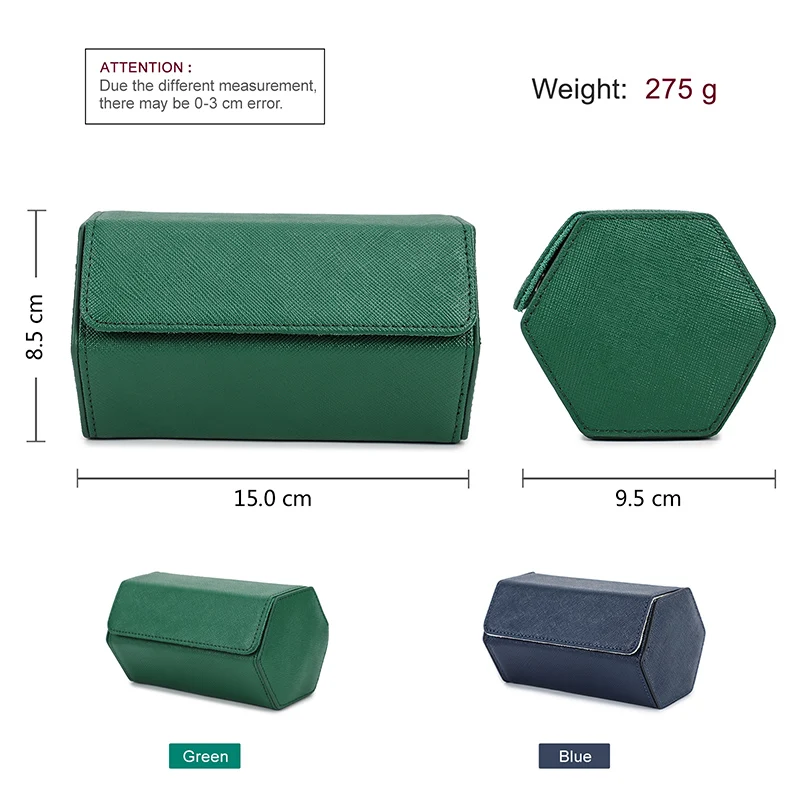
Understanding these differences helps guide your decision based on your specific needs rather than marketing terminology. Many enthusiasts discover that as their collection grows, their watch storage ideas evolve from simple holders to more comprehensive organization systems.
How to Choose Between a Watch Holder and Organizer
Selecting the right storage solution depends on several key factors related to your collection and lifestyle:
Collection Size Considerations
- 1-3 watches: Single watch stands or a small watch roll typically suffice
- 4-10 watches: A dedicated watch box or multiple holders become practical
- 10+ watches: Comprehensive organizers or multiple boxes are often necessary
Consider not just your current collection size but your anticipated growth. Investing in a slightly larger organizer can accommodate future acquisitions without requiring immediate replacement.
Type of Watches Owned
- Automatic watches: Consider watch winders or organizers that accommodate winding modules
- Luxury timepieces: Higher protection levels are warranted—premium boxes with secure closures
- Vintage pieces: Climate-controlled organizers may be necessary to prevent deterioration
- Sports/tool watches: More durable models may work well with simpler holders
Primary Use Case Analysis
- Daily rotation between a few watches: Desktop holders provide convenient access
- Frequent travel: Compact rolls or travel cases offer portability with protection
- Display of prized pieces: Glass-top boxes or display stands highlight special watches
- Long-term storage: Fully enclosed organizers with humidity control protect investments
Protection Level Assessment
- Consider your local environment (humidity, dust, sunlight exposure)
- Evaluate the value of your collection—protection should scale accordingly
- Think about pets, children, or other factors that might increase risk to exposed watches
- Balance accessibility needs with security concerns
Space and Placement Considerations
- Measure available space in your preferred location
- Consider whether you want your collection visible or discreetly stored
- Evaluate aesthetic fit with your bedroom, office, or closet décor
- Think about lighting and temperature fluctuations in your chosen location
Budget Evaluations
While budget-friendly watch storage options exist, consider the value of what you’re protecting. A $30 holder might be perfectly adequate for a $200 watch, but insufficient for a collection worth thousands. Proper watch collection storage planning helps balance immediate costs against long-term protection.
Specific Recommendations for Different Watch Collectors
For the Casual Wearer (1-3 watches)
A quality watch stand for your daily timepiece and a simple watch roll for occasional travel provides an excellent starting point. Look for:
- A stable, well-cushioned stand for your most-worn watch
- A compact travel option that prevents scratches
- Minimal footprint on your dresser or nightstand
- Budget range: $15-50 total investment
These simple solutions balance convenience with basic protection without unnecessary features or capacity you won’t use.
For the Frequent Traveler (2-4 watches)
Travel demands specialized storage solutions that balance protection with portability:
- Invest in a high-quality leather or canvas watch roll with individual dividers
- Consider padded travel cases with secure closures for valuable collections
- Look for compact designs that easily slip into carry-on luggage
- Prioritize crush-resistance and water-resistant materials
- Budget range: $40-120 depending on material quality
Quality travel solutions for watches prevent damage during transport while specialized watch travel cases offer enhanced protection for those who frequently change time zones with their timepieces.
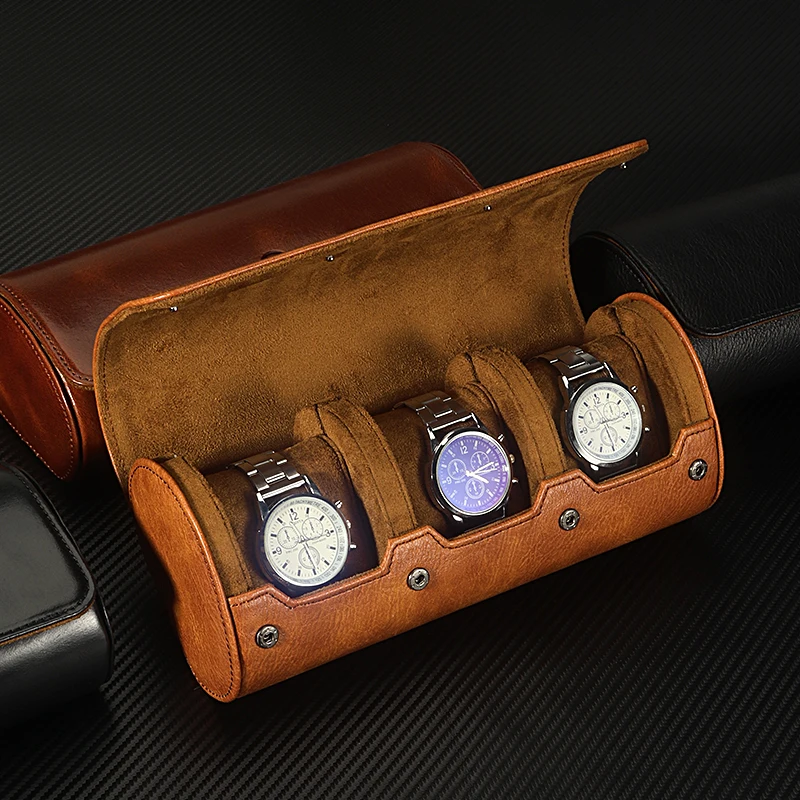
For the Growing Collection (5-10 watches)
As your collection expands, organization becomes increasingly important:
- A quality watch box with 10-12 slots allows room for growth
- Consider options with removable dividers for flexibility
- Look for individual cushions that accommodate different watch sizes
- Glass-top designs balance protection with visibility
- Budget range: $75-150 for quality mid-range options
This transitional phase often benefits from combination approaches—a display box for most of the collection plus a holder for the currently worn piece.
For the Serious Enthusiast (10+ watches)
Substantial collections require comprehensive storage strategies:
- Multiple coordinated boxes or a large-capacity cabinet
- Watch winders for frequently worn automatic pieces
- Specialized storage for particularly valuable watches
- Inventory system for tracking pieces in storage
- Budget range: $200+ with higher-end options reaching $1,000+
Serious collectors often develop luxury watch storage setups that incorporate multiple storage types, climate control, and security features appropriate to their investment level.
For the Display-Focused Collector
Some collectors prioritize seeing and showcasing their watches:
- Glass-topped boxes or wall-mounted display cases
- Strategic lighting to highlight watch details
- Consideration of UV-protected glass for valuable pieces
- Secure but accessible placement in living spaces
- Budget range: Varies widely based on display quality and capacity
Display-focused collectors balance visibility with protection, often creating dedicated areas where their timepieces become conversation pieces and decorative elements.
Material Quality and Construction Considerations
The materials used in watch storage significantly impact both protection level and aesthetic appeal:
Wood Options
- Walnut: Rich dark tones, excellent durability, premium appearance
- Cherry: Warm reddish hues that deepen over time, good stability
- Oak: Strong grain patterns, excellent durability, traditional appearance
- Cedar: Natural aromatic properties, helps repel insects, casual appearance
- Bamboo: Sustainable option, light coloration, modern aesthetic
Look for properly seasoned hardwoods with quality finishes that won’t transfer color to watch bands. Solid wood construction generally outperforms particleboard or MDF options for durability.
Leather Varieties
- Full-grain leather: Highest quality, develops attractive patina, extremely durable
- Top-grain leather: Good balance of quality and price, uniform appearance
- Genuine leather: Lower quality but functional, less durability
- Synthetic options: Vegan-friendly, consistent appearance, variable durability
Leather products require occasional conditioning to prevent drying and cracking, particularly in dry climates.
Glass and Display Materials
- Tempered glass: Safer when broken, moderate scratch resistance
- Mineral glass: Good clarity, moderate scratch resistance, affordable
- Sapphire crystal: Premium option, exceptional scratch resistance, higher cost
- Acrylic: Lightweight, shatter-resistant, but scratches easily
Look for UV-protected options to prevent fading of watch dials and straps, especially for watches with vintage or colored faces.
Interior Lining Materials
- Velvet: Luxurious appearance, good scratch protection, attracts dust
- Microfiber: Excellent scratch protection, less dust attraction, modern look
- Suede: Soft texture, good protection, requires cleaning care
- Foam with fabric covering: Customizable fit, good support, variable quality
Quality watch pillows should be firm enough to support watches without compressing but soft enough to prevent bracelet stretching.
Construction Quality Markers
- Box joints or dovetail corners: Superior strength and craftsmanship
- Piano hinges: Distribute weight evenly and prevent lid sagging
- Quality closure mechanisms: Magnetic closures, secure clasps, or locks
- Felt-lined bottoms: Protect furniture surfaces from scratching
Attention to these details often distinguishes premium storage options that will last for decades from shorter-lived alternatives.
For specific insights on materials, explore comprehensive guides to watch box materials and construction or leather watch case care.
Maintenance and Care for Watch Storage Solutions
Proper maintenance of your storage solutions helps preserve both your watches and their housing:
Regular Cleaning Protocols
- Dust exterior surfaces weekly using a soft microfiber cloth
- Clean glass components with appropriate non-ammonia cleaners
- Vacuum interior compartments quarterly using soft brush attachments
- Remove watches before deep cleaning to prevent damage
Environmental Protection
- Position watch storage away from direct sunlight to prevent fading
- Maintain moderate humidity levels (40-60%) to protect both watches and storage materials
- Keep storage at consistent room temperature, avoiding attics or basements with fluctuations
- Consider room placement carefully—bathrooms expose watches to moisture, kitchens to grease
Cushion and Interior Maintenance
- Inspect cushions regularly for compression or deformation
- Clean removable cushions according to material instructions
- Adjust cushions to accommodate different watch sizes properly
- Replace worn components before they can damage watches
Special Considerations for Watch Winders
- Follow manufacturer guidelines for rotation settings
- Periodically check that winding functions are working correctly
- Consider turning off winders during extended periods of non-use
- Keep power adapters and cords organized and protected
Implementing proper long-term watch storage protection practices ensures that both your timepieces and their storage solutions remain in excellent condition for years to come.
Combining Holders and Organizers for Optimal Watch Care
Many collectors find that the ideal strategy involves using both holders and organizers in complementary ways:
Creating a Comprehensive Watch Storage System
A well-thought-out system might include:
– A watch stand on your dresser for tomorrow’s selection
– A quality watch box in your closet for the core collection
– A travel roll for business trips
– A watch winder for frequently worn automatic pieces
This multi-tiered approach addresses different needs while ensuring all watches receive appropriate care.
Strategic Placement Within the Home
Consider how different storage solutions fit into your living space:
– Decorative holders in visible bedroom or office locations
– Larger organizers in closets or dedicated display areas
– Travel options stored with luggage or in a designated drawer
– Climate-sensitive pieces in the most stable environment
Thoughtful watch storage placement enhances both protection and the aesthetic contribution of your collection to your living space.
Transitioning Between Systems
Establish habits for moving watches between storage options:
– When selecting a watch for wear, immediately place the previous one in proper storage
– Before travel, transition selected pieces from main storage to travel cases
– Rotate automatic watches between winders and static storage based on wear patterns
– Implement seasonal rotation for collections that exceed daily display capacity
Collection Growth Management
As your collection evolves, your storage strategy should adapt:
– Begin with quality over quantity—invest in better storage for fewer watches
– Add complementary pieces that work with your existing system
– Consider modular systems that can expand with your collection
– Periodically reevaluate if your current solutions still meet your needs
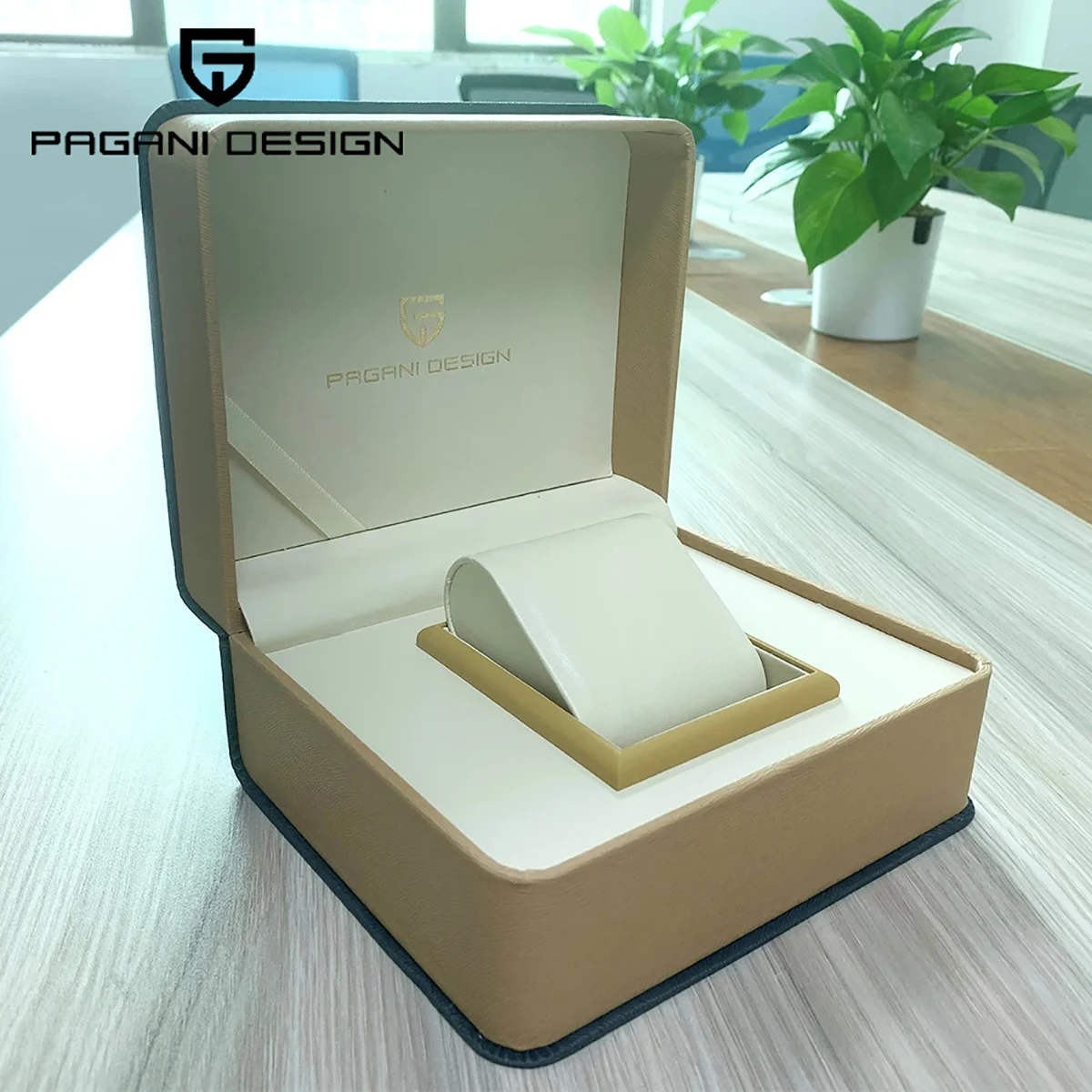
Creating an effective display system for your watches often involves multiple storage types working together to balance accessibility, protection, and visual appeal.
Common Mistakes to Avoid When Storing Watches
Even experienced collectors can make these common storage errors:
Inadequate Protection Relative to Watch Value
Many collectors use storage solutions that don’t match their collection’s value:
– Storing luxury timepieces in basic holders without environmental protection
– Using travel storage as permanent solutions for valuable watches
– Failing to secure high-value collections appropriately
– Underinvesting in quality storage relative to watch investment
The protection level should scale appropriately with the value of your collection.
Improper Cushioning and Fit
Watch damage often results from improper support:
– Stretching bracelets around cushions that are too large
– Compressing leather straps on cushions that are too small
– Overcrowding watches in limited space
– Using rigid cushions that don’t accommodate different watch sizes
Proper fit prevents unnecessary strain on bracelets, clasps, and case attachment points.
Environmental Exposure Problems
Many collectors unintentionally expose their watches to harmful conditions:
– Placing watch storage in direct sunlight, fading dials and straps
– Storing in areas with high humidity, risking moisture damage
– Exposing to temperature extremes that affect lubricants and movement accuracy
– Failing to protect from household dust and airborne particles
Environmental factors can cause damage that accumulates slowly but requires expensive servicing to remedy.
Storage System Mismatch
Using the wrong type of storage for your specific needs leads to problems:
– Using open display stands for long-term storage of valuable watches
– Relying on travel cases for everyday home storage
– Over-investing in elaborate systems for modest collections
– Under-investing in protection for valuable collections
Match your storage type to your specific collection profile and usage patterns.
Organization Inefficiencies
Poor organization creates frustration and potential damage:
– Difficulty finding specific watches in poorly organized systems
– Handling multiple watches unnecessarily when selecting one to wear
– Inefficient use of available space
– Lack of system for tracking watches in storage
Even collectors with limited space can implement watch storage solutions for small spaces that maintain organization and protection.
Conclusion: Making Your Final Decision
The fundamental difference between watch holders and organizers comes down to their primary purpose: holders excel at displaying and providing easy access to a small number of watches, while organizers focus on comprehensively protecting and managing larger collections.
Holders prioritize accessibility and display, making them perfect for daily wear watches that you frequently rotate. Their open designs showcase your timepieces as decorative elements while keeping them ready for immediate use. However, this convenience comes with limited protection.
Organizers, by contrast, offer superior protection against environmental factors and physical damage. Their enclosed designs with individual compartments keep collections secure, organized, and preserved for the long term. They represent a more significant investment but provide substantial benefits for serious collectors.
The right choice ultimately depends on your unique situation—your collection size, the types of watches you own, how you use them, and your storage environment. Many enthusiasts find that as their collection grows, their storage needs evolve from simple holders to more comprehensive organization systems.
Remember that proper storage is an investment in preserving your timepieces. Whether you choose holders, organizers, or a combination of both, quality storage solutions help ensure that your watches remain in excellent condition, ready to be enjoyed for years to come.

